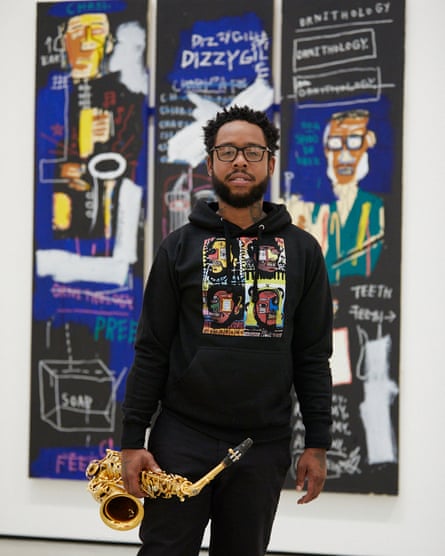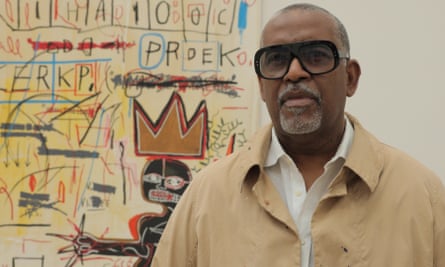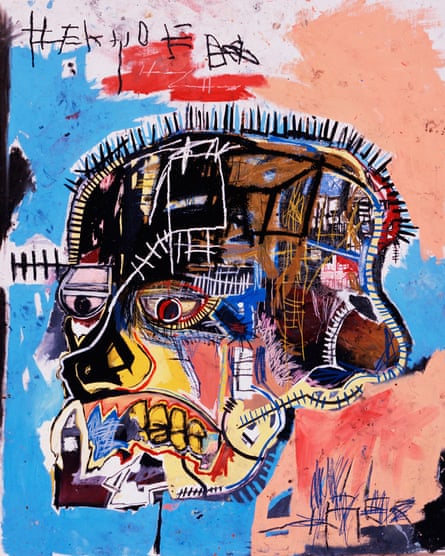Jean Michel Basquiat Horn Players
Before Jean-Michel Basquiat became one of the leading art stars of the 1980s, he was a child from Brooklyn thriving in the music and fine art scenes of downtown New York in the late 1970s.
"Everyone was coexisting together, musicians and artists," says Ed Patuto, the producer of Time Decorated: The Musical Influences of Jean-Michel Basquiat, three short films that explore the creative person'southward relationship to bebop, no wave, and hip-hop. "You lot would go to a gallery, run into a evidence, terminate upwards at [legendary Due east Village lodge] the Pyramid. Moving between platforms and genres was what people did."

Time Decorated takes a trip through Basquiat'south musical influences and adventures from hip-hop to jazz and back again. The three films are helmed by the rapper, musician and producer Terrace Martin, the Afro-Punk director James Spooner and Dr Todd Boyd, a professor at USC's Schoolhouse of Cinematic Arts.
"It's hard to wait at a Basquiat painting and not come to terms with his musical influences," says Patuto who is too the director for audience engagement at the Wide museum in Los Angeles.
The series was produced in the middle of the pandemic as a way for the Broad museum, which has one of the largest public collections of Basquiat artwork in the The states, to share with audiences online. The Broad'due south founders, the businessman and philanthropist Eli Broad, who died in May, and his married woman, the fine art collector and philanthropist Edythe, began collecting Basquiat in the 1980s, ownership early works for as little equally $five,000, far below the creative person's auction tape of $110m set in 2017.
For the Broad's fifth anniversary final fall, the museum had planned to showroom all 13 paintings together for the first fourth dimension, merely pandemic shutdowns, which lasted more than than a year at LA museums, intervened. The paintings hung in an empty gallery for months, awaiting the point from state and local officials to allow visitors dorsum. The Broad finally opened its doors final calendar month.
From jazz to no moving ridge and hip-hop
In the late 70s and early on 80s, Basquiat was frequenting New York venues such every bit the Mudd Guild where punk, no wave, avant garde experimental music, and hip-hop were mixing to create new hybrid forms. No wave itself is hard to define, an annoying, confrontational genre, whose musicians had footling in common except their rejection of the status quo. No wave was "purposefully inaccessible for mainstream consumption" explains Spooner in the second film.
Basquiat formed his own no wave band, Grayness, which took its name from the book Grey'southward Beefcake, which he had been given while recovering from a childhood accident, and remained a lifelong influence. Spooner draws a direct connection betwixt the music'southward volatility and Basquiat'southward turbulent canvases filled with gestural brushwork, anguished figures, and crossed-out words. "Basquiat'southward art looks the way no moving ridge sounds: an untrained raw expression," he says.

Basquiat besides had roots in the burgeoning New York hip-hop scene, from his early graffiti piece of work with Al Diaz collaborating under the proper name SAMO (Same Quondam Shit), to his sleeve pattern and production for Shell Bop, a 1983 single by Rammellzee and K-Rob. (In 1981, he also appeared as a DJ in Blondie'due south Rapture, the first music video with a rap to appear on MTV.)
In the third picture, Dr Todd Boyd likens Basquiat'southward employ of text to the manner a DJ scratches a record, using previously recorded cloth to make a new sound. "When I see Basquiat crossing out text, crossing out words, information technology, for me, has often implied something like scratching," he explains, "specially what this ways in terms of early hip-hop, this concept of the remix comes through quite strongly when one looks at how often Basquiat would use this device."
If hip-hop and no wave were the musical styles that Basquiat lived through, jazz and bebop were his historical touchstones. Standing in forepart of Basquiat's 1983 painting Horn Players, which depicts bebop legends Charlie Parker and Dizzy Gillespie, Terrace Martin describes the affinities between Basquiat and the jazz icons. "1 of his [Parker'south] goals in ushering in this new wave of bebop players was to put a end to the whole 'y'all gotta entertain me, you're a Black jazz musician' thing," says Martin. "Basquiat was consistently aware of the racist ways in which he was beingness pigeonholed, so he constitute a lot of parallels betwixt his handling every bit an creative person and that of his jazz heroes."

Against the backdrop of a largely white art world, Basquiat looked to other Blackness creatives who had forged their ain paths in similar circumstances. Dr Boyd connects the recurring image of the crown in Basquiat's paintings, seen in With Strings Two (1983) in the Broad drove, to the jazz and hip-hop artists who gave themselves royal aliases. From Count Basie and Knuckles Ellington, to Run-DMC's Male monarch of Stone, Blackness artists accept often given themselves honorifics denied to them by the white cultural mainstream. (Despite Basquiat'southward commercial success, Martin notes, he was dismissed past several critics, including Hilton Kramer who, in 1997, described Basquiat as "a talentless hustler, street-smart only otherwise invincibly ignorant, who used his youth, his looks, his skin color, and his abundant sex entreatment" to garner fame).
In the 3rd film, Dr Boyd links the seemingly chaotic, confrontational style of Basquiat's paintings to the layered, intricate production of hip-hop producers similar the Bomb Squad who created Public Enemy's signature sound. "The music doesn't necessarily get out to the listener. It expects that the listener, if the listener is going to empathise, volition come to the music."
In a similar way he notes, "you can't view Basquiat'south work passively, it requires that you actively engage with the textile."
Jean Michel Basquiat Horn Players,
Source: https://www.theguardian.com/artanddesign/2021/jun/11/jean-michel-basquiat-music-influences-broad-museum
Posted by: crousesligized56.blogspot.com


0 Response to "Jean Michel Basquiat Horn Players"
Post a Comment